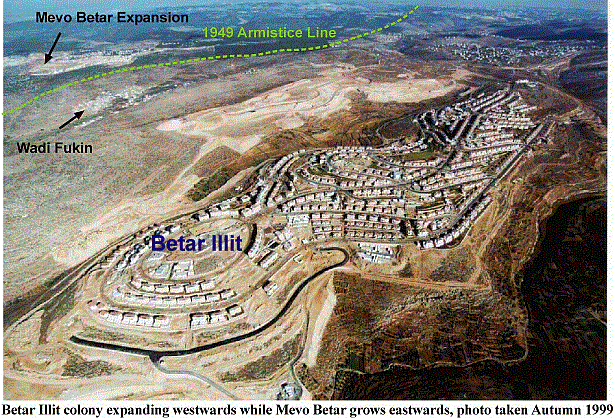In the far western part of Bethlehem district there are three Palestinian villages, Husan, Wadi Fukin and Nahhalin. In between these three villages two ''Betar Settlements'' have been built, Hadar Betar and Betar Illit. There are currently more than 11,000 settlers in Betar Illit. Close by on the other side of the 1949 Armistice line there is the Israeli town of Mevo Betar. The close location of Hadar Betar and Betar Illit to the 1949 Armistice Line and their proximity to the Israeli town Mevo Betar on the other side of the line make these settlements likely targets for formal annexation to Israel in the future; see photo. Separation plans released by the Barak administration mark the area between Betar Illit and the West Bank border for annexation; see map. This case study takes a look at the changes being made west of Bethlehem that suggest the existence of plans for separation.
Activities that suggest an edging towards complete annexation can be seen at most of the settlements along the 1949 Armistice Line. (For details on other cases click here). Betar Illit is no exception. The checkpoint on the road linking Bet Shemesh to Gilo settlement is located close to the border between the West Bank and Israel. At the beginning of January 2001, the Israeli army moved the main structures of the checkpoint to a new location approximately half a kilometer east, towards Bethlehem; see map and photo. This new checkpoint is unmanned between 9am and 3pm each day, allowing free access to the Israeli owned petrol station, which is located close to the original checkpoint; see photo. For the rest of the time, the new checkpoint becomes operational. This makes it very difficult for Palestinians to access the area between the checkpoint and the 1949 Armistice Line. In addition, work has begun on a new road near the original checkpoint, suggesting that more development may be planned for the area that is now effectively annexed by the moving of the checkpoint.
A new military camp has also been set up in the last month in the area between Betar Illit settlement and Husan village; see map. With a number of tents and ringed by a high fence, this enlargement of the military presence in the area only further adds to the strength of nearby settlers and increases the fear of local Palestinians.. With a number of tents and ringed by a high fence, this enlargement of the military presence in the area only further adds to the strength of nearby settlers and increases the fear of local Palestinians.
Without waiting for the outcome of the current political negotiations, building work continues on the northeastern side of Betar Illit towards the Israeli town of Mevo Betar; see photo. Betar Illit is one of the most rapidly expanding settlements in the West Bank. Its population doubled in just three years between 1995 and 1998.. Betar Illit is one of the most rapidly expanding settlements in the West Bank. Its population doubled in just three years between 1995 and 1998.
Population growth
|
Population |
Average annual growth 96-98 |
|||
|
1995 |
1996 |
1997 |
1998 |
|
|
5,500 |
7,570 |
9,760 |
11,300 |
22.35% |
Sources: Statistical Abstracts of Israel
The expansion of this settlement not only encircles Wadi Fukin but also threatens its existence. In the 1997 Census, 881 people were living in Wadi Fukin in 151 households. Perched high on the ridge of a hill, Betar Illit settlement looks down on one side into Nahhalin village and on the other to Wadi Fukin. The settlement has already built right up against Nahhalin village; see photo. The new area being developed will bring the settlement also oppressively close to the residents of Wadi Fukin village. But perhaps an even greater worry is the possibility that if Israel formally annexes Betar Illit settlement then they may also try to annex the land between the settlement and the West Bank border. Both the agricultural land and the village itself are likely to be threatened by annexation. The continuation of construction on a large scale at Betar Illit indicates a high degree of confidence, on the part of investors, that the area of this settlement will remain under Israeli control for the foreseeable future.
Wadi Fukin village is in a precarious position. Not only is its land threatened, but also the village's only access road must be reached by using road 375, the Israeli by-pass road. The checkpoint has already been moved to just before the entrance to Wadi Fukin. Any further move would affectively annex the village to Israel. Even if the checkpoint remains at its current location, the ability of Wadi Fukin villagers to enter and exit their village will remain dependent on Palestinian cars being allowed to continue to travel on this section of the by-pass road.
By moving the checkpoint, installing a new military base and continuing building work, Israel shows disregard for the negotiation process. Only by suspending all such changes would they indicate a willingness to take the talks seriously. By going ahead with their own plans, the Israelis give little reason to trust that they will honour the outcome of negotiations as it is the negotiations which should decide what changes can occur.
Prepared by:
The Applied Research Institute – Jerusalem



















